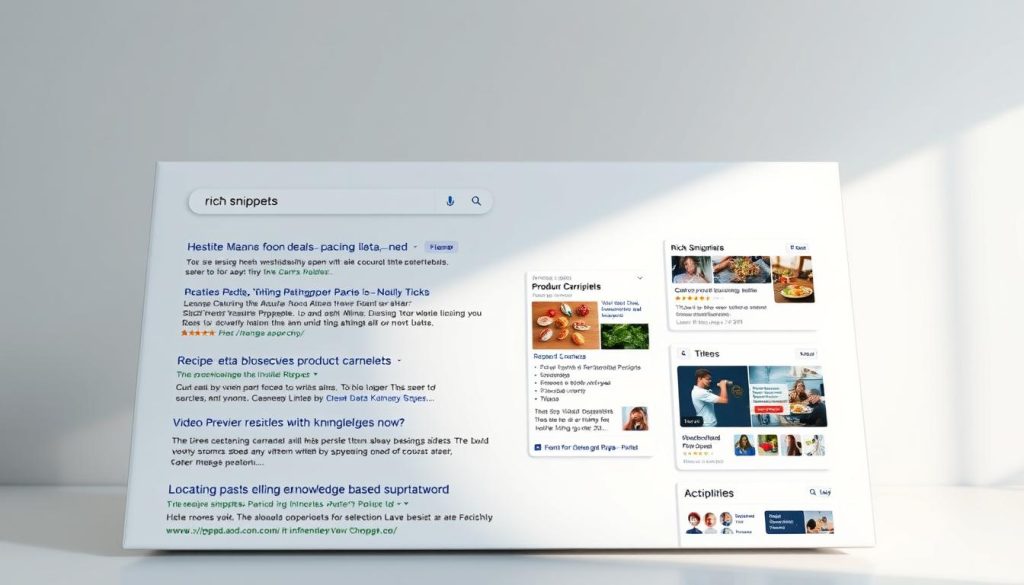Search engine results have evolved dramatically over the years. Today’s search pages offer much more than basic blue links. Enhanced search displays provide immediate value to users seeking quick answers.
These enhanced results, known as rich snippets, transform standard listings into information-rich displays. They show extra details like ratings, prices, and images directly in search results. This visual enhancement helps webpages attract more attention and traffic.
Google introduced this feature in 2009 to improve user experience. The system collects information from special code called structured data markup. This technical implementation allows websites to communicate more effectively with search engines.
Implementing structured data creates visually appealing search listings that stand out from competitors. The benefits include increased visibility, better user engagement, and higher click-through rates. This makes enhanced results an essential component of modern SEO strategy.
Table of Contents
Key Takeaways
- Enhanced search results provide extra details like ratings and prices directly in search listings
- Structured data markup enables websites to communicate effectively with search engines
- These visual enhancements significantly improve click-through rates and user engagement
- Implementation requires technical knowledge but offers substantial visibility benefits
- Different content types can benefit from various enhanced result formats
- Proper implementation bridges technical SEO and user experience improvements
- Enhanced displays have evolved search engines beyond basic link presentations
What Are Rich Snippets and Their SEO Impact
Enhanced search results have transformed how users interact with search engines. These visual improvements provide immediate value by displaying extra information directly in search listings.

Definition and Evolution
Rich snippets are enhanced search displays that show additional data beyond standard titles and descriptions. They include elements like star ratings, product prices, and review counts.
Google introduced this feature in 2009 to improve user experience. The evolution from basic results to information-rich displays marked a significant shift in search engine presentation.
The term « rich results » is often used interchangeably with rich snippets. Both refer to the same enhanced search experience that benefits both users and website owners.
SEO Benefits and Enhanced Visibility
While these enhanced displays don’t directly affect rankings, they create substantial indirect benefits. The visual appeal naturally attracts more attention from searchers.
Improved click-through rates send positive signals to Google about content relevance. Higher engagement can lead to better organic positions over time as the algorithm recognizes user preference.
| Standard Search Result | Enhanced Result with Rich Snippet | Impact Difference |
|---|---|---|
| Basic title and description | Includes ratings, prices, images | Higher visual appeal |
| Standard blue link | Additional structured data elements | Increased user trust |
| Average click-through rate | Improved engagement metrics | Better performance signals |
Structured data markup serves dual purposes. It helps search engines understand page content while enabling these enhanced displays that drive measurable improvements.
Exploring Different Rich Snippet Types
Content creators can leverage several distinct enhanced result categories to improve visibility. Each format serves specific content needs and audience expectations.
Understanding these options helps websites choose the right markup for their content. This alignment maximizes search engine visibility and user engagement.
Popular Examples such as Reviews, Recipes, and Products
Product markup displays essential purchasing information directly in search results. E-commerce sites benefit from showing prices, availability, and ratings.
Review snippets create immediate trust through star ratings and feedback counts. These visual elements significantly boost click-through rates across various content types.

Recipe formats showcase cooking details like preparation time and ingredient lists. Food blogs can display nutritional information and user ratings effectively.
| Snippet Type | Key Elements | Best For |
|---|---|---|
| Product Markup | Price, availability, ratings | E-commerce sites |
| Review Snippet | Star ratings, review counts | Product and service pages |
| Recipe Format | Cooking time, ingredients, calories | Food blogs and websites |
| Article Snippet | Author, publication date, image | News and blog content |
Additional formats include organization profiles and event listings. Each type offers unique advantages for specific business objectives.
The right snippet type matches your content’s purpose and audience needs.
Video snippets help preview content with thumbnails and timestamps. These are particularly valuable for educational or entertainment websites.
Implementing Structured Data for Enhanced Results
The practical application of structured data markup begins with selecting the appropriate format for your content. Schema.org serves as the universal standard accepted by all major search engines. This foundation ensures your données structurées communicate effectively with search systems.
Three primary formats exist for implementing this code: JSON-LD, microdata, and RDFa. Google recommends JSON-LD for its clean separation from HTML content. This format simplifies implementation and debugging processes significantly.
Google’s Structured Data Markup Helper provides a visual interface for tagging page elements. This tool generates the appropriate balisage without requiring deep programming knowledge. It’s an excellent starting point for implementing rich snippets on your site.

WordPress users can leverage plugins like Rank Math and Yoast SEO. These tools simplify données structurées addition through user-friendly interfaces. They handle the technical code while you focus on content.
Breadcrumb markup defines your page position within site hierarchy. This structured data helps search engines understand content relationships. Alternative implementation methods include direct HTML insertion and Google Tag Manager.
Leveraging Rich Snippets for Superior SEO Performance
Beyond technical implementation, enhanced results demand thoughtful performance strategies. Proper markup goes beyond correctness to encompass user psychology and competitive positioning.

Structured Data Best Practices
Accurate données structurées implementation requires including all required properties. Avoid marking up invisible content and maintain consistency between visible contenu and structured data.
Regular updates ensure information reflects current details. This maintains visibilité and prevents misleading utilisateurs in résultats recherche.
Optimizing User Engagement and CTR
Enhanced displays create immediate value by showing ratings and prices before clicks. Users pre-qualify results based on this information, improving overall expérience.
Select visually appealing snippet types for your page content. Ensure high-quality reviews and compelling images display effectively.
The compounding effect drives trafic growth. Enhanced visibilité leads to more clicks, signaling content relevance to search engines.
Establish baseline metrics before implementation. Track current search position, organic trafic, and click-through taux. Google processes new données structurées within 3-5 days.
Monitor KPIs after implementation to measure true performance impact. Competitive differentiation comes from maintaining higher review counts and current pricing information.
Technical Setup and Validation of Rich Snippets
Google provides powerful tools to verify that your structured data meets all requirements. Proper testing ensures search engines can properly interpret your content for enhanced displays.
Testing and Validating Structured Data
Use Google’s Rich Results Test to check your données structurées. Enter your URL and click « Test URL » to analyze the code. The tool shows detected items and highlights errors.
Google Search Console offers ongoing monitoring for your entire site. It alerts you to new issues when Google crawls your pages. This helps maintain valid balisage over time.
Semrush Site Audit provides an alternative validation method. Configure a project and run a full crawl of your site. Navigate to the Markup section to identify pages with invalid données.
| Validation Tool | Primary Function | Best For | Integration |
|---|---|---|---|
| Google Rich Results Test | URL or code validation | Quick individual page checks | Standalone tool |
| Google Search Console | Site-wide monitoring | Ongoing maintenance | Google ecosystem |
| Semrush Site Audit | Comprehensive SEO analysis | Integrated platform users | Third-party SEO suite |
Remember that final display decisions belong to Google’s algorithms. Even with valid données structurées, enhanced results may not appear immediately. Regular validation prevents issues from website updates.
Establish a testing workflow before pushing code to production. Validate all relevant pages rather than spot-checking. Document results for future reference and troubleshooting.
Avoiding Common Errors and Pitfalls
Even properly implemented structured data can fail to generate enhanced results if common errors persist. Technical validation represents only the first step toward sustainable performance.
Pages with invalid données structurées won’t appear as enhanced extraits enrichis. This makes error identification crucial for maintaining search visibility.
Troubleshooting Markup Issues
Common markup errors include syntax mistakes in JSON-LD formatting. Incorrect property names that don’t match Schema.org specifications also cause problems.
Missing required fields prevents extrait eligibility. Search engines cannot parse improperly nested data structures effectively.
| Error Type | Common Cause | Impact on Results |
|---|---|---|
| Invalid Syntax | JSON-LD formatting errors | Complete markup failure |
| Missing Properties | Required fields not included | Ineligible for enhanced display |
| Content Inconsistency | Markup doesn’t match visible content | Manual action risk |
| Outdated Information | Prices, ratings not updated | Misleading users in search |
The critical error of marking up invisible content violates Google’s guidelines. Your balisage must accurately reflect what users see on the page.
Maintaining Updated Data and Fixing Invalid Markup
Regular adjustments keep your données current as Schema.org standards evolve. Google’s requirements change over temps, requiring ongoing attention.
Keep review avis current as new feedback arrives. Update product pricing and availability as inventory changes. This maintenance ensures your site maintains competitive position.
Structured data implementation requires continuous maintenance, not one-time setup.
Use structured data audit tools to identify problems systematically. Regular crawls help prioritize errors based on affected pages importance.
The temps investment justifies itself through improved click-through rates. Though requiring dedication, the benefits in organic performance make the effort worthwhile.
Conclusion
Transforming standard listings into engaging search experiences remains a cornerstone of modern SEO. Rich snippets provide this competitive edge by displaying valuable information directly in search results.
While implementation requires initial setup, numerous tools simplify the process for all technical levels. The benefits in click-through rates and organic performance justify the time investment.
Enhanced results work alongside quality content and technical optimization for comprehensive SEO success. They improve visibility and user engagement without altering ranking positions.
Stay current with Schema.org updates to maintain your competitive advantage. Begin implementation with your most relevant content types and expand as results demonstrate value.
The strategic use of structured data delivers sustainable traffic growth and improved user experiences. This makes rich snippets an essential component of any serious SEO strategy.
FAQ
What exactly are rich snippets?
Rich snippets are enhanced search results that display extra information directly on the search engine results page. They use structured data markup from your website’s code to show details like star ratings, cooking times, or product prices. This helps your listing stand out and gives users more context before they click.
How do rich snippets improve my website’s SEO?
They significantly boost your click-through rate (CTR) by making your search listing more attractive and informative. A higher CTR can indirectly signal to Google that your page is relevant and valuable, potentially improving your ranking position over time. They also enhance the user experience by providing key information upfront.
What are some common types of enhanced search results I can implement?
Some of the most popular formats include review snippets, which show star ratings and review counts; recipe snippets, displaying preparation time, calories, and ratings; and product snippets, highlighting price, availability, and ratings. Other common types are FAQ pages, how-to guides, and event listings.
How do I add structured data to my website for these enhanced results?
You add structured data by inserting specific code, like JSON-LD, into the HTML of your web pages. This code uses a standardized vocabulary (Schema.org) to label your content in a way search engines understand. For example, you would mark up a product’s name, price, and review rating with the appropriate Schema.org tags.
What is the best way to test if my structured data is correct?
Google provides free tools to test and validate your markup. The Rich Results Test tool is the most current and reliable option. You can paste your code or a URL into the tool to see if it detects any errors and get a preview of how your page might appear in Google Search.
What are some common mistakes to avoid with structured data?
A frequent error is marking up content that is not visible to the user on the page. Another is using outdated or incorrect vocabulary. It’s also crucial to keep your data updated; for instance, an out-of-stock product should not still show as « InStock » in the markup. Always validate your code to catch these issues.





